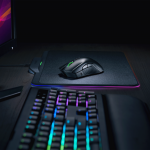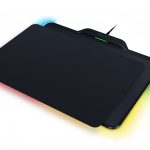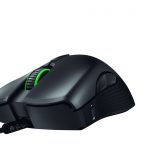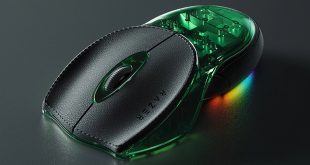Fresh off the announcement of Corsair’s wave of wireless peripherals, Razer is throwing its hat into the ring with its new HyperFlux technology. The difference here, is that the Razer Mamba HyperFlux and the Razer Firefly HyperFlux manage to shed the need for a battery while maintaining cordless use.
This is all thanks to Razer’s HyperFlux technology, in which the Razer Firefly HyperFlux Mouse Pad creates a magnetic field to transfer power directly into the Razer Mamba HyperFlux mouse. Removing the battery entirely from the Mamba HyperFlux ensures that the mouse is ultra-lightweight, similar to that of its wired counterparts. In fact, it’s lighter than the wired Mamba, coming in at 96 grams instead of the original’s 133 grams.
HyperFlux could be considered a double-edged sword, as while there are many benefits to owning an ultra-lightweight gaming mouse with no need for wires or even considering battery life, the Razer Mamba HyperFlux simply doesn’t work when paired with any other mouse pad.
Luckily, the Firely HyperFlux is versatile in that its surface can be interchanged between a hard surface akin to that of the original Firefly, or a softer surface that mimics the those sat at the majority of desks. Plus, just like the mouse, it sports Razer’s signature Chroma RGB lighting, unlike other wireless charging mouse pads.
Further improving upon the original Mamba, the Mamba HyperFlux sheds its old laser sensor for a 16,000 DPI optical sensor, a wise move for such a lightweight mouse that skates beneath the user’s hand, as I find laser sensors tend to be a lot more sensitive.
Considering, the Mamba HyperFlux isn’t particularly customisable, the steep price of $250 for it combined with Firefly HyperFlux is sure to make some people’s eyes water, especially knowing that the mouse cannot be bought separately. Both should be available by end of Q1 2018.
KitGuru Says: I’ve been looking a lot into wireless mouse pads charging wireless mice, and while this has its perks, the inability to take the mouse elsewhere is too limiting for my tastes. Of course, both Corsair’s and Logitech’s attempt have their limitations too, but they also offer a lot more in return, such as the ability to charge other devices, or use the mouse anywhere. What do you think of Razer’s HyperFlux devices?
 KitGuru KitGuru.net – Tech News | Hardware News | Hardware Reviews | IOS | Mobile | Gaming | Graphics Cards
KitGuru KitGuru.net – Tech News | Hardware News | Hardware Reviews | IOS | Mobile | Gaming | Graphics Cards





